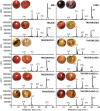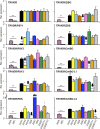Dissection of tomato lycopene biosynthesis through virus-induced gene silencing
- PMID: 24014574
- PMCID: PMC3793073
- DOI: 10.1104/pp.113.224733
Dissection of tomato lycopene biosynthesis through virus-induced gene silencing
Abstract
Lycopene biosynthesis in tomato (Solanum lycopersicum) fruits has been proposed to proceed through a poly-cis pathway catalyzed by phytoene synthase (PSY), two desaturases (phytoene desaturase [PDS] and ζ-carotene desaturase [ZDS]), and two cis-trans isomerases (ζ-carotene isomerase [ZISO] and prolycopene isomerase [CrtISO]). The mechanism of action of these enzymes has been studied in Escherichia coli, but a systematic study of their in vivo function is lacking. We studied the function of nine candidate genes (PSY1, PSY2, PSY3, PDS, ZDS, ZISO, CrtISO, CrtISO-Like1, and CrtISO-Like2) using virus-induced gene silencing (VIGS) coupled to high-resolution liquid chromatography coupled with diode array detector and mass spectrometry, which allowed the identification and quantitation of 45 different carotenoid isomers, including linear xanthophylls. The data confirm the confinement of the VIGS signal to the silenced fruits and the similarity of the phenotypes of PSY1- and CrtISO-silenced fruits with those of the yellow flesh and tangerine mutants. Light was able to restore lycopene biosynthesis in ZISO-silenced fruits. Isomeric composition of fruits silenced at different metabolic steps suggested the existence of three functional units, comprising PSY1, PDS/ZISO, and ZDS/CrtISO, and responsible for the synthesis of 15-cis-phytoene, 9,9'-di-cis-ζ-carotene, and all-trans-lycopene, respectively. Silencing of a desaturase (PDS or ZDS) resulted in the induction of the isomerase in the same functional unit (ZISO or CrtISO, respectively). All-trans-ζ-carotene was detectable in nonsilenced fruits, greatly increased in ZDS-silenced ones, and disappeared in CrtISO-Like1-/CrtISO-Like2-silenced ones, suggesting the existence of a metabolic side branch, comprising this compound and initiated by the latter enzymes.
Figures








Similar articles
-
Cloning of tangerine from tomato reveals a carotenoid isomerase essential for the production of beta-carotene and xanthophylls in plants.Plant Cell. 2002 Feb;14(2):333-42. doi: 10.1105/tpc.010303. Plant Cell. 2002. PMID: 11884678 Free PMC article.
-
Virus-induced gene silencing in detached tomatoes and biochemical effects of phytoene desaturase gene silencing.J Plant Physiol. 2011 Jul 1;168(10):1129-35. doi: 10.1016/j.jplph.2010.12.020. Epub 2011 Mar 5. J Plant Physiol. 2011. PMID: 21377758
-
zeta-Carotene cis isomers as products and substrates in the plant poly-cis carotenoid biosynthetic pathway to lycopene.Planta. 2005 Mar;220(5):785-93. doi: 10.1007/s00425-004-1395-2. Epub 2004 Oct 21. Planta. 2005. PMID: 15503129
-
Carotenoids, versatile components of oxygenic photosynthesis.Prog Lipid Res. 2013 Oct;52(4):539-61. doi: 10.1016/j.plipres.2013.07.001. Epub 2013 Jul 26. Prog Lipid Res. 2013. PMID: 23896007 Review.
-
Progress on molecular breeding and metabolic engineering of biosynthesis pathways of C(30), C(35), C(40), C(45), C(50) carotenoids.Biotechnol Adv. 2007 May-Jun;25(3):211-22. doi: 10.1016/j.biotechadv.2006.12.001. Epub 2006 Dec 19. Biotechnol Adv. 2007. PMID: 17257797 Review.
Cited by
-
Zeta-Carotene Isomerase (Z-ISO) Is Required for Light-Independent Carotenoid Biosynthesis in the Cyanobacterium Synechocystis sp. PCC 6803.Microorganisms. 2022 Aug 27;10(9):1730. doi: 10.3390/microorganisms10091730. Microorganisms. 2022. PMID: 36144332 Free PMC article.
-
Inside and Beyond Color: Comparative Overview of Functional Quality of Tomato and Watermelon Fruits.Front Plant Sci. 2019 Jun 13;10:769. doi: 10.3389/fpls.2019.00769. eCollection 2019. Front Plant Sci. 2019. PMID: 31263475 Free PMC article. Review.
-
High-resolution spatiotemporal transcriptome mapping of tomato fruit development and ripening.Nat Commun. 2018 Jan 25;9(1):364. doi: 10.1038/s41467-017-02782-9. Nat Commun. 2018. PMID: 29371663 Free PMC article.
-
An association mapping approach to identify favourable alleles for tomato fruit quality breeding.BMC Plant Biol. 2014 Dec 3;14:337. doi: 10.1186/s12870-014-0337-9. BMC Plant Biol. 2014. PMID: 25465385 Free PMC article.
-
Exploring the differential stages of the pigment metabolism by pre-harvest bagging and post-harvest ethylene de-greening of Eureka lemon peel.PeerJ. 2021 Jun 8;9:e11504. doi: 10.7717/peerj.11504. eCollection 2021. PeerJ. 2021. PMID: 34164234 Free PMC article.
References
-
- Alder A, Jamil M, Marzorati M, Bruno M, Vermathen M, Bigler P, Ghisla S, Bouwmeester H, Beyer P, Al-Babili S. (2012) The path from β-carotene to carlactone, a strigolactone-like plant hormone. Science 335: 1348–1351 - PubMed
-
- Bartley GE, Scolnik PA, Beyer P. (1999) Two Arabidopsis thaliana carotene desaturases, phytoene desaturase and zeta-carotene desaturase, expressed in Escherichia coli, catalyze a poly-cis pathway to yield pro-lycopene. Eur J Biochem 259: 396–403 - PubMed
-
- Baulcombe DC. (1999) Fast forward genetics based on virus-induced gene silencing. Curr Opin Plant Biol 2: 109–113 - PubMed
-
- Bonk M, Hoffmann B, Von Lintig J, Schledz M, Al-Babili S, Hobeika E, Kleinig H, Beyer P. (1997) Chloroplast import of four carotenoid biosynthetic enzymes in vitro reveals differential fates prior to membrane binding and oligomeric assembly. Eur J Biochem 247: 942–950 - PubMed
Publication types
MeSH terms
Substances
LinkOut - more resources
Full Text Sources
Other Literature Sources
Miscellaneous

